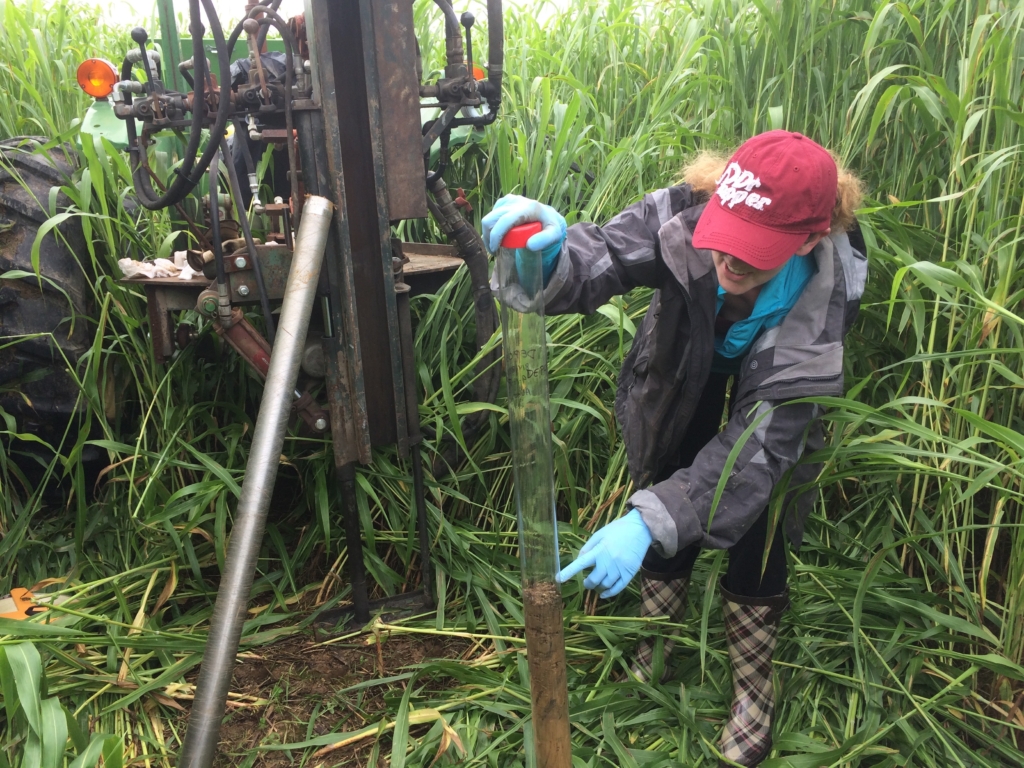The Living Filter at Pennsylvania State University features 600 acres of agricultural land and forest, much of which is sprayed with wastewater (called effluent) from a local wastewater treatment plant and has acted as a research site for decades. Researchers recently completed a 5-year study that observed how soils in the Living Filter could act as a tertiary treatment for wastewater, preventing antibiotic compounds from entering groundwater. “This is one of the few sites on the east coast using effluent to irrigate the soil and conduct a long-term analyses on its filtration ability,” explained Jack Watson, who heads the group that led the study.

Alison Franklin, Ph.D. candidate in Soil Science and Biogeochemistry, points out the top of the soil profile in the soil core she just sampled from The Living Filter site at Penn State University, a wastewater reuse research site. Photo Credit: John Watson
The team analyzed three antibiotics in the groundwater and soil of the Living Filter: sulfamethoxazole (SMX), ofloxacin (OFL), and trimethoprim (TMP). Doctoral student and lead researcher Alison Franklin sampled soil that hadn’t been spray irrigated in 8 months, and then again after 10 weeks of irrigation, and also took groundwater samples three times per year over five years. She wanted to test the concentration of the antibiotics that end up in the groundwater after wastewater had been filtered through the soil.
Researchers found SMX at the highest concentrations in the wastewater treatment plant effluent, with OFL and TMP at lower concentrations. Franklin found that OFL tended to remain in the soil for the longest period of time, accumulating in the soil profile. SMX also built up in the soil, but only after 10 weeks of irrigation events, and TMP was only detectable after 10 weeks of irrigation, suggesting that SMX and TMP will likely not remain in the soil after effluent irrigation stops.
In the groundwater, only SMX was found consistently, which is evidence that the soil acted as a successful filter. Franklin hypothesized that this is probably because SMX is a more hydrophilic compound that can work its way through the soil along with the water.
Franklin took several steps to choose the antibiotics used in the study. First, she contacted University Health Services at PSU and asked which antibiotics were most prescribed. From that list, she looked at which compounds were most commonly found in waterways in Pennsylvania and in the United States. She chose the compounds that had strong implications for human and environmental health and were present in the effluent sprayed on the Living Filter.
Before beginning the study, Franklin hypothesized that the soil composition of the Living Filter would filter some of the antibiotics. Franklin spent two years during her Masters research developing a methodology for testing concentrations of antibiotics in the soil and groundwater, studying the unique soil composition of the Living Filter. The top layer of the soils is silt loam, and there is higher clay content farther down. At its deepest, the Living Filter soil profile reaches 100 feet, providing plenty of space to filter out the antibiotics. The team predicted that the soil and microorganisms that live there would help break down the antibiotics. Plants could also uptake some of the contaminants. Watson noted of Franklin’s research, “most people who work in this area work on water samples. The uniqueness of this study is that it’s on soil samples that are very hard to study.”
Other areas in the eastern United States have tried to build their own filters for effluent irrigation, but it has been difficult to implement. Watson sits on the Wastewater Management Committee at PSU that meets about this issue and discusses possible solutions. Out in the west, effluent is commonly used to irrigate crops, golf courses, and turf grass. In the east, however, it can be rare to find the right site. “You have to take into account the type of soil, geology of the area, depth of the soil profile before implementing it,” explained Franklin. “We’re lucky in that this site works out well because of the depth of the soil profile and characteristics of the soil.”
In the future, Franklin wants to study antibiotic-resistance genes and see if these genes are more common in bacteria that are exposed to effluent. “There’s clear links between manure applications on soil causing an increase of antibiotic resistance,” explained Franklin. “There isn’t as much work being done on spray irrigation of effluent.”
Their paper also calls for a national or even global database of concentrations of antibiotics and other compounds to understand trends and risks associated with low-level contaminants. While there is a lot of focus on how these contaminants affect human health, they argue that more research is needed on purely environmental effects. “Everything is pretty closely linked, and people forget about that sometimes,” explained Franklin. “Things that impact the environment can impact human and animal health as well.”
